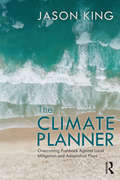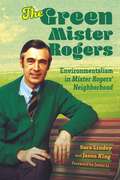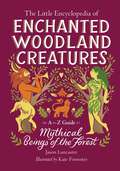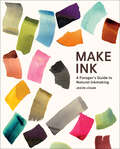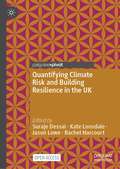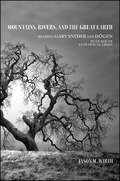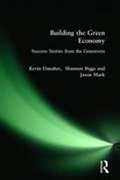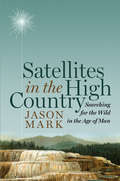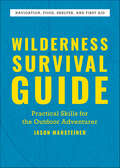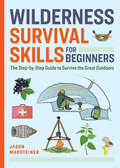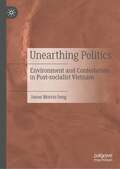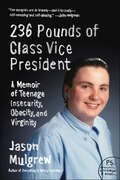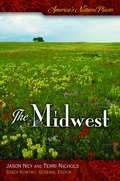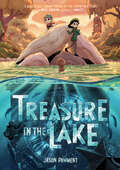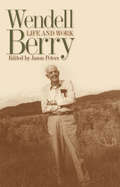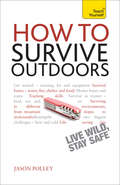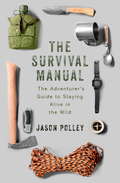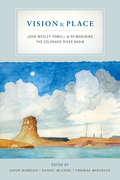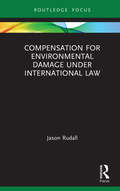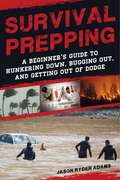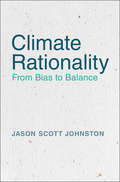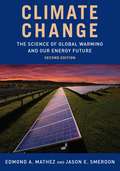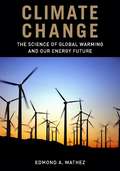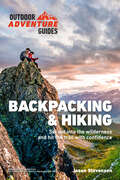- Table View
- List View
The Climate Planner: Overcoming Pushback Against Local Mitigation and Adaptation Plans
by Jason KingThe Climate Planner is about overcoming the objections to climate change mitigation and adaption that urban planners face at a local level. It shows how to draft climate plans that encounter less resistance because they involve the public, stakeholders, and decisionmakers in a way that builds trust, creates consensus, and leads to implementation. Although focused on the local level, this book discusses climate basics such as carbon dioxide levels in the atmosphere, the Intergovernmental Panel on Climate Change, the Paris Agreement of 2015, worldwide energy generation forecasts, and other items of global concern in order to familiarize urban planners and citizen planners with key concepts that they will need to know in order to be able to host climate conversations at the local level. The many case studies from around the United States of America show how communities have encountered pushback and bridged the implementation gap, the gap between plan and reality, thanks to a commitment to substantive public engagement. The book is written for urban planners, local activists, journalists, elected or appointed representatives, and the average citizen worried about climate breakdown and interested in working to reshape the built environment.
The Green Mister Rogers: Environmentalism in Mister Rogers' Neighborhood (Children's Literature Association Series)
by Jason King Sara LindeyFred Rogers was an international celebrity. He was a pioneer in children’s television, an advocate for families, and a multimedia artist and performer. He wrote the television scripts and music, performed puppetry, sang, hosted, and directed Mister Rogers’ Neighborhood for more than thirty years. In his almost nine hundred episodes, Rogers pursued dramatic topics: divorce, death, war, sibling rivalry, disabilities, racism. Rogers’ direct, slow, gentle, and empathic approach is supported by his superior emotional strength, his intellectual and creative courage, and his joyful spiritual confidence. The Green Mister Rogers: Environmentalism in “Mister Rogers’ Neighborhood” centers on the show’s environmentalism, primarily expressed through his themed week “Caring for the Environment,” produced in 1990 in coordination with the twentieth anniversary of Earth Day. Unfolding against a trash catastrophe in the Neighborhood of Make-Believe, Rogers advances an environmentalism for children that secures children in their family homes while extending their perspective to faraway places, from the local recycling center to Florida’s coral reef. Rogers depicts animal wisdom and uses puppets to voice anxiety and hope and shows an interconnected world where each part of creation is valued, and love is circulated in networks of care. Ultimately, Rogers cultivates a practical wisdom that provides a way for children to confront the environmental crisis through action and hope and, in doing so, develop into adults who possess greater care for the environment and a capacious imagination for solving the ecological problems we face.
The Little Encyclopedia of Enchanted Woodland Creatures: An A-to-Z Guide to Mythical Beings of the Forest (The Little Encyclopedias of Mythological Creatures)
by Jason LancasterRunning the gamut from A-to-Z and spanning the globe from the forest glens of Romania to the mountain aeries of Colorado, The Little Encyclopedia of Enchanted Woodland Creatures brings together all the most magical creatures of the forest. Naughty and nice, real and fictional, the menagerie of creatures included in this book encompass multiple world mythologies and cultures. This little encyclopedia features more than 90 famous woodland creatures from around the world, including: Andvari—a magical ring wearing dwarf from Norse Mythology who lives under a waterfall Baba Yaga—one of the most potent witches in all of folklore, said to live deep in the Russian forest Glawackus—a fearsome creature of the American woods that looks like a mix between a bear, a lion, and a panther Sasabonsam—creatures from Ghanaian folklore with red hair and iron teeth who are said to feast on those who wander past their forest home Also filled with descriptions of other powerful forest beings like dryads, fauns, elves, and gnomes, this information-packed guide includes gorgeous line drawings throughout.
Make Ink: A Forager's Guide to Natural Inkmaking
by Jason Logan“The pigments he concocts from these humble beginnings are as fun to make as they are eye-opening to work with . . . the world never quite looks the same.” —MarthaStewart.comA 2018 Best Book of the Year—The GuardianThe Toronto Ink Company was founded in 2014 by designer and artist Jason Logan as a citizen science experiment to make eco-friendly, urban ink from street-harvested pigments. In Make Ink, Logan delves into the history of inkmaking and the science of distilling pigment from the natural world. Readers will learn how to forage for materials such as soot, rust, cigarette butts, peach pits, and black walnut, then how to mix, test, and transform these ingredients into rich, vibrant inks that are sensitive to both place and environment. Organized by color, and featuring lovely minimalist photography throughout, Make Ink combines science, art, and craft to instill the basics of ink making and demonstrate the beauty and necessity of engaging with one of mankind’s oldest tools of communication.“Logan demystifies the process, encouraging experimentation and taking a fresh look at urban environments.” —NPR“The book is full of inspiration and takes a lot of the mystery out of ink making, at least at its simplest level. And it also reminds me why I love ink—any ink or liquid color as much as I do.” —The Well-Appointed Desk“Quite a few recipes . . . that use color from the kitchen: carrots, black beans, blueberries, turmeric, and onion skins all make beautiful ink colors.” —Design Observer“Make Ink opens up about methods, providing an open source guide to DIY ink.” —CityLab
Quantifying Climate Risk and Building Resilience in the UK
by Jason Lowe Suraje Dessai Kate Lonsdale Rachel HarcourtThis open access book draws together key research from the UK Climate Resilience programme. It focuses on topics central to the programme’s research agenda, including improved characterisation and quantification of climate risks, enhanced understanding of the management of climate risks, and the development and delivery of climate services. Key chapters address the challenges inherent to undertaking resilience research, including how to make the term ‘climate resilience’ usable and useful, co-producing research between academics, policy makers and practitioners, and engaging and communicating outside of academia. This book is unique in providing a concise and accessible overview of the programme’s key lessons, placing the findings into a wider context and it will inform future research, policy and practice agendas.
Mountains, Rivers, and the Great Earth: Reading Gary Snyder and Dōgen in an Age of Ecological Crisis (SUNY series in Environmental Philosophy and Ethics)
by Jason M. WirthFINALIST for the 2017 Foreword INDIES Book of the Year Award in the Philosophy categoryMeditating on the work of American poet and environmental activist Gary Snyder and thirteenth-century Japanese Zen Master Eihei Dōgen, Jason M. Wirth draws out insights for understanding our relation to the planet's ongoing ecological crisis. He discusses what Dōgen calls "the Great Earth" and what Snyder calls "the Wild" as being comprised of the play of waters and mountains, emptiness and form, and then considers how these ideas can illuminate the spiritual and ethical dimensions of place. The book culminates in a discussion of earth democracy, a place-based sense of communion where all beings are interconnected and all beings matter. This radical rethinking of what it means to inhabit the earth will inspire lovers of Snyder's poetry, Zen practitioners, environmental philosophers, and anyone concerned about the global ecological crisis.
Building the Green Economy
by Kevin Danaher Shannon Biggs Jason MarkAfter centuries of economic activity based on extraction, exploitation, and depletion, we now face undeniable environmental threats. New business models that save or restore natural resources are critical. But how can we translate that insight into more sustainable practices? Building the Green Economy shows how community groups, families, and individual citizens have taken action to protect their food and water, clean up their neighborhoods, and strengthen their local economies. Their unlikely victories-over polluters, unresponsive bureaucracies and unexamined routines-dramatize the opportunities and challenges facing the local green economy movement.
Satellites in the High Country: Searching for the Wild in the Age of Man
by Jason MarkIn New Mexico's Gila Wilderness, 106 Mexican gray wolves may be some of the most monitored wildlife on the planet. Collared, microchipped, and transported by helicopter, the wolves are protected and confined in an attempt to appease ranchers and conservationists alike. Once a symbol of the wild, these wolves have come to illustrate the demise of wilderness in this Human Age, where man's efforts shape life in even the most remote corners of the earth. And yet, the howl of an unregistered wolf--half of a rogue pair--splits the night. If you know where to look, you'll find that much remains untamed, and even today, wildness can remain a touchstone for our relationship with the rest of nature. In Satellites in the High Country, journalist and adventurer Jason Mark travels beyond the bright lights and certainties of our cities to seek wildness wherever it survives. In California's Point Reyes National Seashore, a battle over oyster farming and designated wilderness pits former allies against one another, as locals wonder whether wilderness should be untouched, farmed, or something in between. In Washington's Cascade Mountains, a modern-day wild woman and her students learn to tan hides and start fires without matches, attempting to connect with a primal past out of reach for the rest of society. And in Colorado's High Country, dark skies and clear air reveal a breathtaking expanse of stars, flawed only by the arc of a satellite passing--beauty interrupted by the traffic of a million conversations. These expeditions to the edges of civilization's grid show us that, although our notions of pristine nature may be shattering, the mystery of the wild still exists -- and in fact, it is more crucial than ever. But wildness is wily as a coyote: you have to be willing to track it to understand the least thing about it. Satellites in the High Country is an epic journey on the trail of the wild, a poetic and incisive exploration of its meaning and enduring power in our Human Age.
Wilderness Survival Guide: Practical Skills for the Outdoor Adventurer
by Jason MarsteinerLearn the skills you need to thrive in the wildWhether you're an avid adventurer or a bushcraft beginner, this wilderness survival guide can help you level up your outdoor IQ and boost your confidence on remote trips and treks. Get pro tips for navigation, finding food, building shelters, and even applying basic first aid. Discover how to tackle any situation, from running into poisonous plants to staying safe while adventuring in various climates and terrains.This outdoor survival guide features:A practical approach—This portable guide features step-by-step instructions for using a compass, starting a fire, trapping wild game, and more.Easy-to-follow info—Clear illustrations, simple diagrams, and full-color photos offer quick and effective references, even on the go.Life-saving skills—Discover vital advice for campers, anglers, backpackers, hikers, kayakers, and other outdoor adventurers.Master survival training—navigation, food, shelter, and first aid—that could save your life in the wild.
Wilderness Survival Skills for Beginners: The Step-by-Step Guide to Survive the Great Outdoors
by Jason MarsteinerLearn the skills to survive the wild!Are you an aspiring adventurer? A bushcraft beginner? Then you've come to the right place. This guide shows you how to level up your survival skills and boost your confidence when you're out exploring the wilderness. Get pro tips on navigation, finding food, building shelters, and basic first aid from expert survivalist Jason Marsteiner. You'll learn how to tackle any situation, like chance encounters with wild animals or poisonous plants, as well as ways to stay safe while trekking through any climate or terrain.No experience required—This easy-reference manual introduces the basics of survival and bushcraft with step-by-step instructions, diagrams, and illustrations that are perfect for first-time trekkers.The most essential skills—Learn the key survival and emergency skills for any situation, including how to start a fire, locate water, trap game, identify plants, use a compass, and more.For all types of adventure—Whether you're camping, hiking, fishing, or rafting, keep this guide on hand to look up anything you need to know.Master survival training that could save your life in the wild!
Unearthing Politics: Environment and Contestation in Post-socialist Vietnam
by Jason Morris-JungThis book examines an important socio-political challenge to the ruling party regime in Vietnam. Vietnam has been the subject of substantial controversy and challenge to the Vietnamese party regime since market reform in the 1980s, especially since the controversy over bauxite mining in the late 2000. Using the environmental dimensions of this problem to highlight a confluence of trends disrupting the nation’s “encrusted politics”, this book open up a space for the in-depth study of the most sensitive issues, bravest activists, and most off limit struggles with the party-state in Vietnam today.
236 Pounds of Class Vice President: A Memoir of Teenage Insecurity, Obesity, and Virginity
by Jason MulgrewJason Mulgrew, popular blogger and author of Everything Is Wrong with Me, continues his depreciating yet hilarious self-reflection with 236 Pounds of Class Vice President. Set in Mulgrew’s high school years, this genuine and honest memoir revisits his teenage antics and escapades as he, while navigating the indignity of puberty, attempts to run for vice president of the student body, displays a penchant for long fur capes, and (naturally) wonders about sex. Mulgrew’s blog, Everything Is Wrong with me, has received more than 200 million hits since its inception in 2004. Complete with awkward, “what was he thinking?” photos—unmitigated proof of Mulgrew’s ungainly adolescence—236 Pounds of Class Vice President is an no-holds-barred yet tender look at the years some of us would rather forget.
America's Natural Places: The Midwest
by Jason Ney Terri NicholsFrom Iowa's Decorah Ice Cave to the Kitty Todd Nature Preserve in Ohio, this volume provides a snapshot of the most spectacular and important natural places in the Midwestern United States.
Treasure in the Lake
by Jason PammentGrand adventures stories often begin where you least expect them…Iris knows this because she’s read them all. However, as a thirteen-year-old stuck in the tiny town of Bugden, real adventure seems like a distant dream. But when Iris and her best friend, Sam, stumble upon an unusually dry river on the outskirts of town, they’re led to a discovery beyond anything Iris has ever read about: a hidden city and a forgotten tale of friendship.In Jason Pamment's middle grade graphic novel debut, perfect for fans of Hilda and This Was Our Pact, can Iris and Sam uncover the truth in time to keep their own friendship afloat, or will history repeat itself and pull them apart forever?An ALSC Graphic Novel Reading List Title
Wendell Berry: Life and Work (Culture of the Land #Cull)
by Jason PetersA portrait of an American thinker with contributions by Barbara Kingsolver, Bill McKibben, Sven Birkerts, Wes Jackson, and more: “A masterful collection.” —Charlotte ObserverEssayist, social critic, poet, “mad farmer,” novelist, teacher, and prophet: Wendell Berry has been called many things, but the broad sweep of his contemporary relevance and influence defies facile labels. With a unique perspective and far-reaching vision, Berry poses complex questions about humankind and our relationship to the land and offers simple but profound solutions. Berry’s writings give voice to a provocative but consistent philosophy that extends far beyond its agrarian core to include elements of sociology, the natural sciences, politics, religion, philosophy, linguistics, agriculture, and other seemingly incompatible fields of study.Wendell Berry: Life and Work examines this wise, original thinker, appraising his written work and exploring his influence as an activist and artist. Each of the contributors—including Hayden Carruth, Sven Birkerts, Barbara Kingsolver, Stanley Hauerwas, Donald Hall, Ed McClanahan, Bill McKibben, Scott Russell Sanders, Norman Wirzba, Wes Jackson, and Eric T. Freyfogle—examines an aspect of Berry’s varied yet cohesive body of work. Also included are highly personal glimpses of Berry: his career, academic influence, and unconventional lifestyle.These deft sketches show the purity of Berry’s agrarian lifestyle and demonstrate that there is nothing simple about the life to which he’s devoted himself. He embraces a life that sustains him not by easy purchase and haste but by physical labor and patience, not by mindless acquiescence to a centralized economy but by attention to local ways and wisdom. This book combines biographical sketches, personal accounts, literary criticism, and social commentary. The result is a rich portrait of one of America’s most profound and honest thinkers.
How to Survive Outdoors: Teach Yourself
by Jason PolleyEvery year, more than 40,000 people climb Mount Kilimanjaro. Millions head for the great outdoors every weekend, and the concept of the Great Outdoors has never been more popular. If you are one of them, would you know what to do if you got stranded or hurt? 'How to Survive Outdoors' gives essential, practical advice for situations that aren't in any way implausible. It starts with ten life-saving tips, then outlines the crucial components - water, food, shelter and so on. It covers scenarios any one of us could encounter, including plane crashes and sinkings.
The Survival Manual: The adventurer's guide to staying alive in the wild (TYG #2)
by Jason PolleyEvery year, more than 40,000 people climb Mount Kilimanjaro. Millions head for the great outdoors every weekend, and the concept of the Great Outdoors has never been more popular. If you are one of them, would you know what to do if you got stranded or hurt?The Survival Manual gives essential, practical advice for situations that aren't in any way implausible. It starts with ten life-saving tips, then outlines the crucial components - water, food, shelter and so on. It covers scenarios any one of us could encounter, including plane crashes and sinkings.
The Survival Manual: The adventurers guide to staying alive in the wild
by Jason PolleyEvery year, more than 40,000 people climb Mount Kilimanjaro. Millions head for the greatoutdoors every weekend, and the concept of the Great Outdoors has never been morepopular. If you are one of them, would you know what to do if you got stranded or hurt?"How to Survive Outdoors" gives essential, practical advice for situationsthat aren't in any way implausible. It starts with ten life-saving tips, then outlinesthe crucial components - water, food, shelter and so on. It covers scenarios any one of uscould encounter, including plane crashes and sinkings.
Vision and Place: John Wesley Powell and Reimagining the Colorado River Basin
by Jason Robison, Daniel McCool, and Thomas MinckleyThe Colorado River Basin’s importance cannot be overstated. Its living river system supplies water to roughly forty million people, contains Grand Canyon National Park, Bears Ears National Monument, and wide swaths of other public lands, and encompasses ancestral homelands of twenty-nine Native American tribes. John Wesley Powell, a one-armed Civil War veteran, explorer, scientist, and adept federal administrator, articulated a vision for Euro-American colonization of the "Arid Region" that has indelibly shaped the basin—a pattern that looms large not only in western history, but also in contemporary environmental and social policy. One hundred and fifty years after Powell’s epic 1869 Colorado River Exploring Expedition, this volume revisits Powell’s vision, examining its historical character and its relative influence on the Colorado River Basin’s cultural and physical landscape in modern times. In three parts, the volume unpacks Powell’s ideas on water, public lands, and Native Americans—ideas at once innovative, complex, and contradictory. With an eye toward climate change and a host of related challenges facing the basin, the volume turns to the future, reflecting on how—if at all—Powell’s legacy might inform our collective vision as we navigate a new "Great Unknown."
Compensation for Environmental Damage Under International Law (Routledge Research in International Environmental Law)
by Jason RudallInspired by recent litigation, this book identifies and critically appraises the manifold and varied approaches to calculating compensation for damage caused to the environment. It examines a wide range of practice on compensation – in general and specifically for environmental damage – from that of international courts and tribunals, as well as international commissions and regimes, to municipal approaches and other disciplines such as economics and philosophy. Compensation for Environmental Damage Under International Law synthesises these approaches with a view to identifying their blind spots, bringing clarity to an area where there exists broad discrepancy, and charting best practices that appropriately balance the manifold interests at stake. In particular, it is argued that best practice methodologies should ensure compensation serves to fully repair the environment, reflect the emerging ecosystems approach and any implications environmental damage may have for climate change, as well as take into account relevant equitable considerations. This book is essential reading for academics, practitioners and students working in the field of environmental law.
Survival Prepping: A Guide to Hunkering Down, Bugging Out, and Getting Out of Dodge
by Jason Ryder AdamsFood, Water, First Aid, and Self-Defense Tips for Surviving Natural Disasters, Extreme Weather, Pandemics, Biological Threats, Terrorist Attacks, and Riots It could be a fire, flood, hurricane, tornado, or hailstorm. Financial system collapse or bioterrorism. Governmental shutdown or societal breakdown. The world is full of possible threats, and they seem to be coming at us from all sides these days. Jason Ryder Adams covers everything you need to know prepare your home, keep your family safe, and get ready to leave if the worst happens. You’ll learn how to: Prep with children and pets (and do test runs ahead of time)Plan for staying put, sealing yourself in, and leaving depending on the threatChoose and protect a safe location and develop an escape routeDefend your family with self-defense training and firearmsPut together a 72-hour emergency kit, bug-out bag, and first aid kit So don’t panic—prepare! Prepping today is for everyone. Survival Prepping is written for ordinary folks who want to get started on preparing for the worst. Adams shares bug-out plans for every scenario, safety tips, and invaluable checklists for acquiring the right supplies for emergency situations. Survival Prepping will help you ensure your family survives—and hopefully thrives—should a disaster strike.
Climate Rationality: From Bias to Balance
by Jason S. JohnstonMost environmental statutes passed since 1970 have endorsed a pragmatic or 'precautionary' principle under which the existence of a significant risk is enough to trigger regulation. At the same time, targets of such regulation have often argued on grounds of inefficiency that the associated costs outweigh any potential benefits. In this work, Jason Johnston unpacks and critiques the legal, economic, and scientific basis for precautionary climate policies pursued in the United States and in doing so sheds light on why the global warming policy debate has become increasingly bitter and disconnected from both climate science and economics. Johnston analyzes the most influential international climate science assessment organizations, the US electric power industry, and land management and renewable energy policies. Bridging sound economics and climate science, this pathbreaking book shows how the United States can efficiently adapt to a changing climate while radically reducing greenhouse gas emissions.
Climate Change: The Science of Global Warming and Our Energy Future
by Jason SmerdonThis second edition of Climate Change is an accessible and comprehensive guide to the science behind global warming. Exquisitely illustrated, the text is geared toward students at a variety of levels. Edmond A. Mathez and Jason E. Smerdon provide a broad, informative introduction to the science that underlies our understanding of the climate system and the effects of human activity on the warming of our planet.Mathez and Smerdon describe the roles that the atmosphere and ocean play in our climate, introduce the concept of radiation balance, and explain climate changes that occurred in the past. They also detail the human activities that influence the climate, such as greenhouse gas and aerosol emissions and deforestation, as well as the effects of natural phenomena. Climate Change concludes with a look toward the future, discussing climate model projections, exploring the economic and technological realities of energy production, and presenting a view of the global warming challenge through the lens of risk. Each chapter features profiles of scientists who advanced our understanding of the material discussed. This new edition expands on the first edition’s presentation of scientific concepts, making it ideal for classroom use for a wide swath of undergraduate and masters students with both science and nonscience backgrounds.
Climate Change: The Science of Global Warming and Our Energy Future
by Jason SmerdonClimate Change is geared toward a variety of students and general readers who seek the real science behind global warming. Exquisitely illustrated, the text introduces the basic science underlying both the natural progress of climate change and the effect of human activity on the deteriorating health of our planet. Noted expert and author Edmond A. Mathez synthesizes the work of leading scholars in climatology and related fields, and he concludes with an extensive chapter on energy production, anchoring this volume in economic and technological realities and suggesting ways to reduce greenhouse-gas emissions.Climate Change opens with the climate system fundamentals: the workings of the atmosphere and ocean, their chemical interactions via the carbon cycle, and the scientific framework for understanding climate change. Mathez then brings the climate of the past to bear on our present predicament, highlighting the importance of paleoclimatology in understanding the current climate system. Subsequent chapters explore the changes already occurring around us and their implications for the future. In a special feature, Jason E. Smerdon, associate research scientist at Lamont-Doherty Earth Observatory of Columbia University, provides an innovative appendix for students.
Backpacking & Hiking: Set Out into the Wilderness and Hit the Trail with Confidence (Outdoor Adventure Guide)
by Jason StevensonHit the trails with all the backpacking and hiking information you needYou know there's nothing quite like spending time with nature, enjoying the fresh air and magnificent vistas. But thinking about where to go, what to bring, and how to protect yourself from the elements might have you feeling less adventurous than you'd like. Well, it's time to get off the couch and onto the trail with Outdoor Adventure Guides: Backpacking and Hiking. Filled with practical tips, this guide gives you all the information you need to survive and thrive in the great outdoors.Packed with information ranging from preparing your body and choosing what to bring to handling the elements and knowing your first aid, this no-nonsense guide has everything you've been looking for in a trail buddy--and its travel-friendly size means it fits in any backpack you bring!So what are you waiting for? Go have an adventure!
